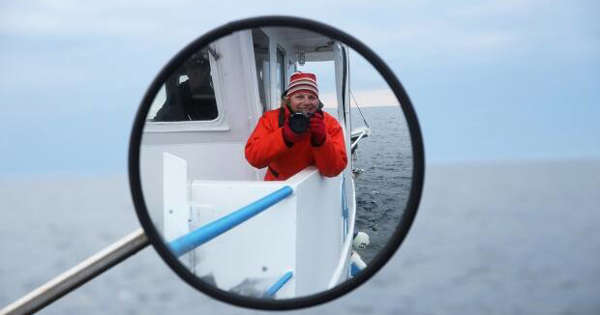[ad_1]
© Julie D’Amour-Léger
Julie D’Amour-Léger takes a selfie on a crab boat. Her love for photography started at the age of 12 when she got her first 35-mm camera.
Three years, 10,000 photos and a deep respect for the fish on her dinner plate: That’s what Julie D’Amour-Léger, a photographer from northeastern New Brunswick, walked away with after exploring a major economic sector in her region — the fishing industry.
D’Amour-Léger is in Fredericton until Saturday working as an artist-in-residence at the Beaverbrook Art Gallery developing her experiences into a book. And unlike during her research, this residency is on land.
During her time on the water, D’Amour-Léger, who is from Caraquet, would often tell the fishermen that she was an artist-in-residence on their boats.
She got started on the project by contacting fishermen, asking if she could join them on their boats. While most were happy to have her come along, she said there was a lot of waiting for good conditions over the years.
She began by shadowing smelt fishers in 2020 as they hauled their nets through a hole in the ice.
After the first year of braving the elements on land, at sea and on ice, she was hooked. She wanted to explore the different fisheries and photograph each one, even if it meant overcoming her usual sea seasickness.
But it was all worth it.
“I wanted to take pictures of people who are just doing what they’re doing, you know, as themselves,” said D’Amour-Léger. “The environment, the colours of their suits, all the equipment — it’s unbelievable. They’re all different.”
She has captured crab, lobster, tuna, smelt, scallop, herring, halibut, eel, shrimp and mackerel fishing — each with its own specific schedule and requirements. She also photographed oyster farming and clam digging on or near the shore.
When she went shrimp fishing, she spent seven days on a boat as the crew embarked on a 35-hour run from Caraquet to Louisbourg, N.S.
Once they arrived, she said the crew lifted the trawling nets, bagged the shrimp and took them to a freezer below deck working five hours at a time. They would sleep a couple of hours and then get up to work for another five.
“They never sleep more than two hours at a time,” recalled D’Amour-Léger.
But she said every journey was different. Out on a crab boat on the Gulf of St. Lawrence, she said the crew worked all day long from sunrise to sunset and slept at night.
D’Amour-Léger’s love for photography started at the age of 12 when she got her first 35-mm camera. She had two friends with dark rooms at their homes, so she had the opportunity to start developing her own photos at an early age. That led her to study visual arts at the University of Moncton and then Concordia University in Montreal.
She made the switch to digital photography 20 years ago, she said, which allowed her to return to New Brunswick in 2007.
“A big city has a lot of resources but when I moved to Caraquet, I just needed my camera and my computer to be able to work,” she said.
One of D’Amour-Léger’s biggest takeaways from her adventures is the dedication of people in the fishing industry, working long hours, doing hard labour.
Since returning, she’s narrowed down her favourite photos from 10,000 to around 120 in preparation for an exhibition at the Galerie d’art Bernard-Jean in Caraquet in November.
“I think the strength of this project is that I have my own photographer’s eye on many kinds of fishing,” said D’Amour-Léger.
“It’s a way of living and I wanted to see all of that…. They were so natural, not looking at me, they were just doing what they’re doing, and it was beautiful to see.”
[ad_2]

